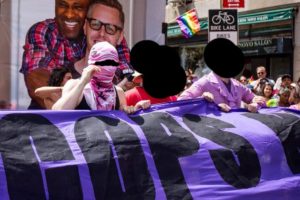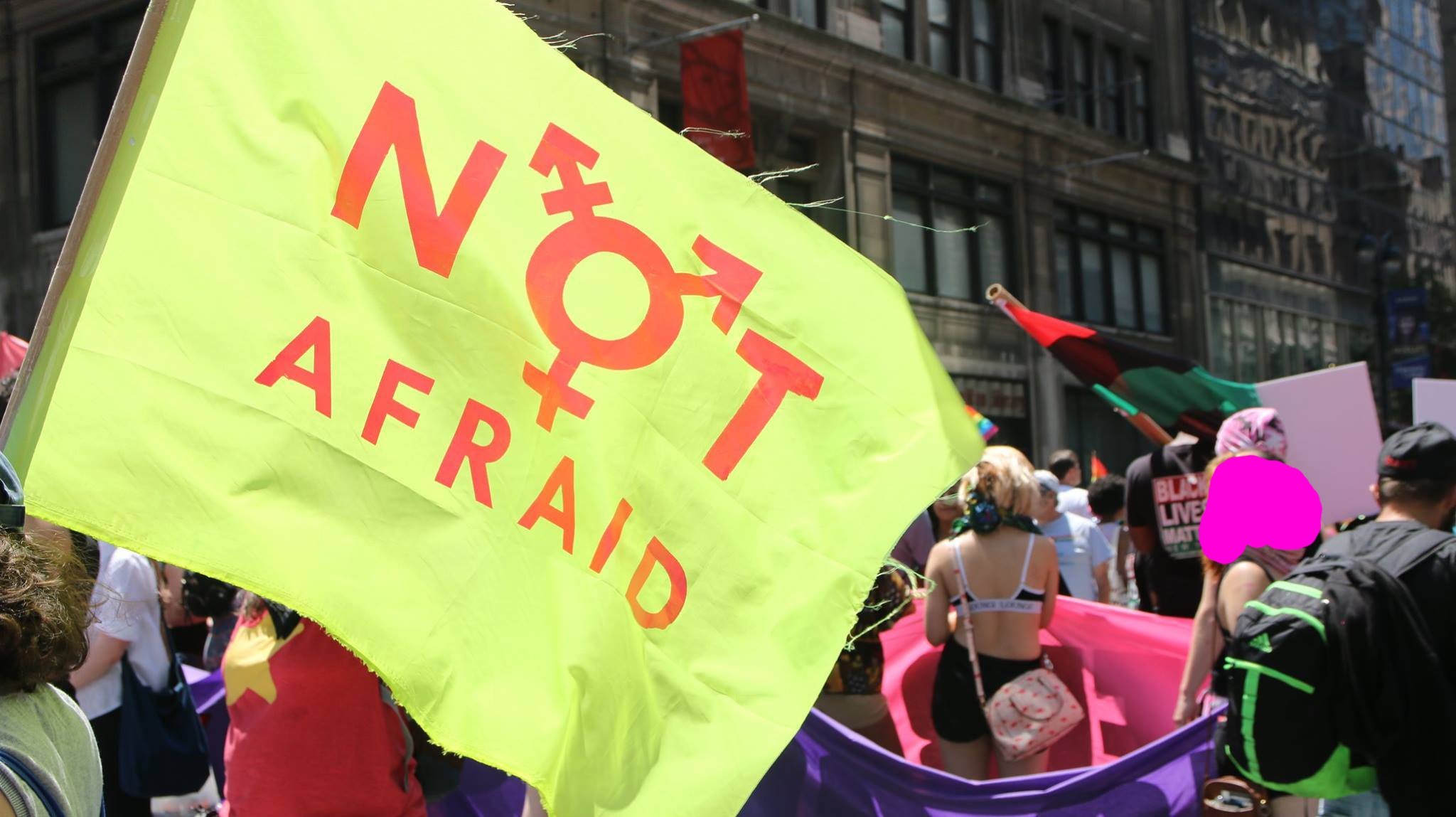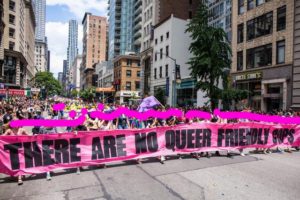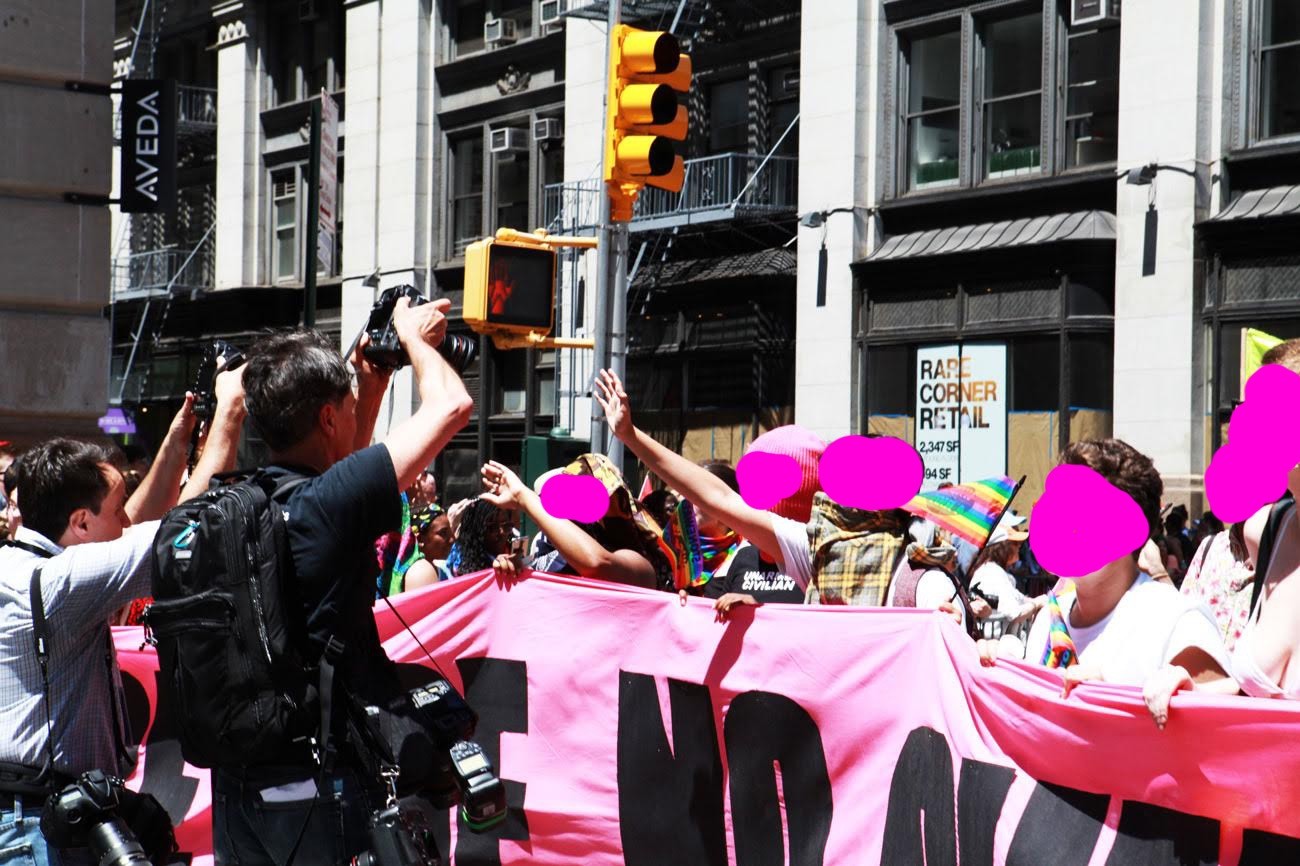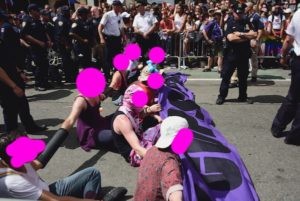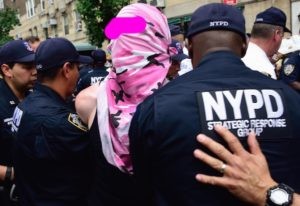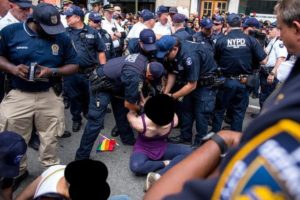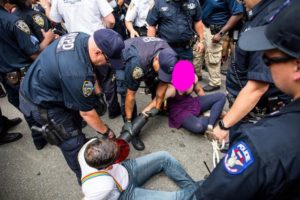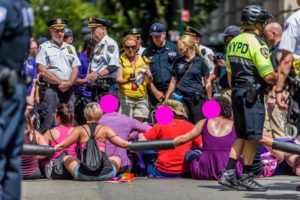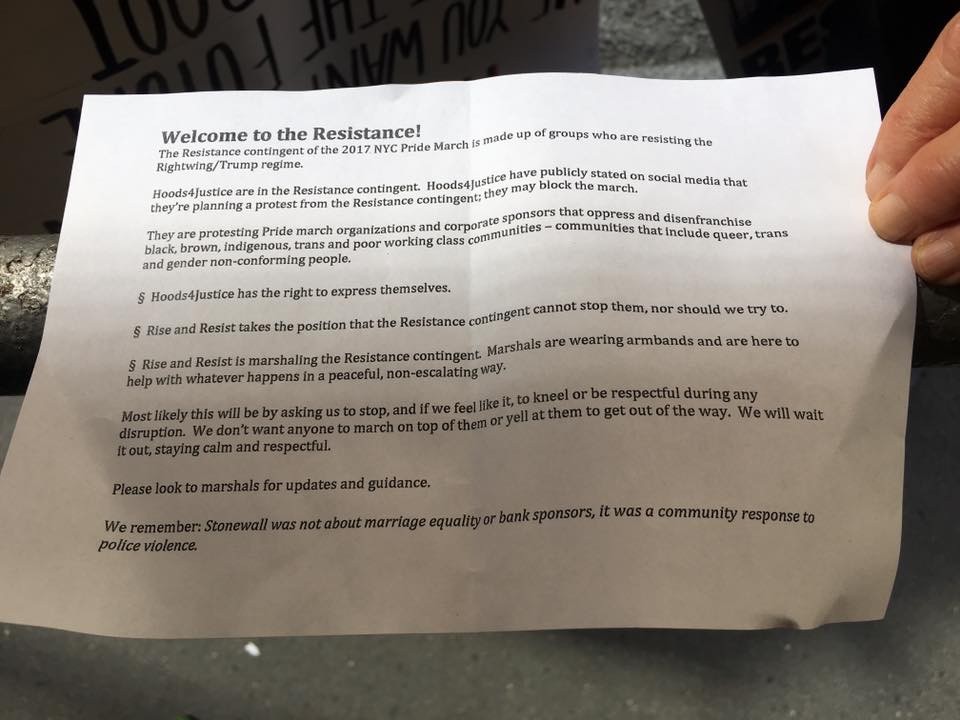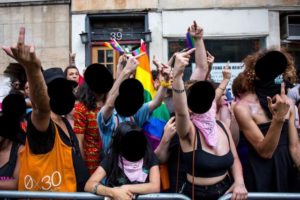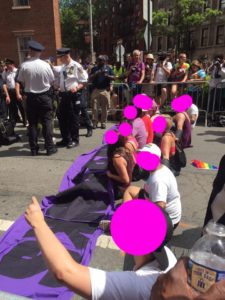Filed under: Action, Northeast, Police, Queer, Trans
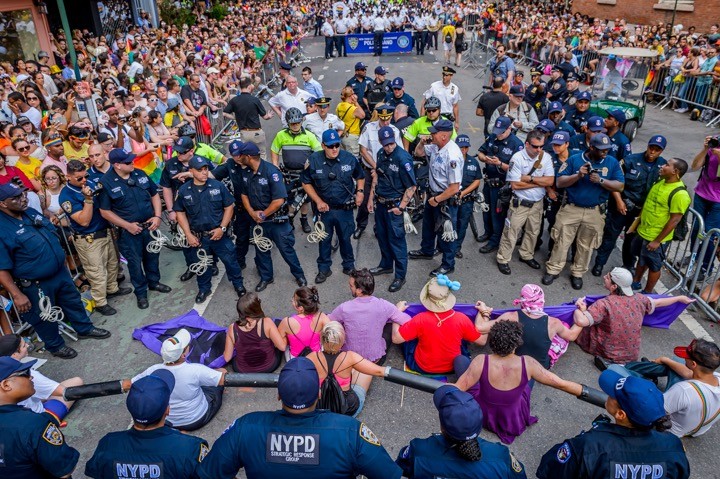
“Plans are worthless, but planning is everything – keep yourself steeped in the character of the problem you are called on to solve.”
Some Photos from Zila Renfro
Noxious as the orator of these words may be, they structured the praxis through which the #NoJusticeNoPride action at NYC Pride 2017 was born and carried out.
A whisper in the late winter became a hushed dialogue in May. And after the June 10th shutdown at Capital Pride, that hushed dialogue roared into anonymized screams. The cat was out of the bag, so to speak. No one had any doubt that a blockade would be attempted at NYC Pride 2017. It was an exhilarating realization.
While we never doubted that New York would not be alone in its opposition to Pride’s corporatization and the welcomed participation of police, June 10th was the billowing signal fire declaring that this was the year queer people, trans people, people of color across the country would defiantly say – for lack of a better term – GTFO of Pride.
And in New York, just as in Columbus, D.C., Chicago, Minneapolis, Seattle, Houston, Phoenix, Vancouver, Toronto, Philadelphia, and elsewhere, that is precisely what happened.
Of course, this is not to suggest that June 2017 was the first time queer, trans, and POC called Pride organizers on their bullshit. Sylvia Rivera wasn’t just speaking in generalities when she said “y’all better quiet down!” But it’s been decades since such a cohesive, interlocking movement has put its collective foot down.
But I’m getting a bit ahead of myself.
Scattered conversations and loose planning for action at Pride 2017 began in the winter of this year, but it wasn’t until immediately following May Day that planning and organizing started to materialize in a substantial way.
Hoods4Justice (H4J), a New York-based anti-colonial anarchist group, put out the initial call for the action. By the time the first organizing meeting was held in early May, members and affiliates of the Metropolitan Anarchist Coordinating Council (MACC) and NYC Shut It Down (SID) were on board. Eventually, we would be joined by members of Black Lives Matter of Greater New York (BLMNY), Bashback, and a large number of individuals affiliated with a myriad of different groups throughout the New York region.
But underneath this barrage of acronyms laid the real essence of what this action and movement were and are: an ad-hoc organization of individuals and collectives coming together and working with one another on the basis of achieving a common goal.
That goal? Stop the police from passing Stonewall.
Or, at least, don’t let them pass without a fight.
Of course, our intentions and desires were and are much more nuanced than that. What began as a multi-day riot in 1969 has, over the years, become the world’s longest Super Bowl commercial break, replete with the participation of the very same organization who unapologetically started this whole thing when they tried to kick our asses one too many times.
Really, our target was less the police, and more the Pride organizers themselves, and much of the LGBTQ community. We wanted to force them into a situation where they would have to choose between the uniformed, armed police contingent or their queer and trans siblings. We were not being divisive, rather, the goal was to shine a light on the division that’s existed within the LGBTQ community since even before Stonewall – a division between those who view the state with star-eyed lenses and favor assimilation and homonormativity versus those who seek a radical shift, a deconstructing and abolition of oppressive societal structures and construction of something truly liberatory to all of us.
But this year was even worse: the Toronto Police Department, having been pushed out by pressure from Black Lives Matter activists and others, would be joining the NYPD in marching right past the closest thing we have to hallowed ground.
Oh, hell no.
So, we organized.
We painted banners, printed flags, dyed parachutes, made shirts, slowly brought in trusted individuals, reached out to and coordinated with permitted groups. We held low-key, core meetings at nondescript locations throughout the city, and held larger semi-public meetings to build this action up to something our whole community could participate in. We created polls and crowd-sourced questionnaires via Facebook to hone our focus.
We wrote communiques and press releases, edited videos and gifs, did interviews and reconned the parade route.
We worked, and we did so together.
June 10th changed everything. After the phenomenal actions in D.C., it became abundantly clear to even a passing observer that New York’s march was going to be met with protest. The need for secrecy had now assumed a different objective. It was no longer about concealing what we were going to do, it was now a matter of concealing how we were going to do it.
This worked very much in our favor, as we now could be more open in reaching out to people for an action that would take place for NYC Pride while still keeping sensitive details to a need-to-know basis.
This year, a number of predominately liberal/progressive activist groups successfully lobbied Heritage of Pride (HOP, the organizers of the march) to allow for a “Resistance contingent.” These same groups (including Rise and Resist, Gays Against Guns, Act Up) lobbied even further for HOP to allow them to march at the front of the parade. HOP reluctantly obliged (except, of course, that smarmy, snakey ass motherfucker Andrew Cuomo would still get his prized spot at the very front).
Our initial plan was to divide ourselves up into three blocs. Those three blocs would enter the march by infiltrating various staging areas. The whole parade’s staging zone was divided up between 8 different areas, each one city block. While HOP got more and more lax with information as the date of the march approached, one thing they did not disclose was where the NYPD contingent would be.
A big part of the reason for splitting up into blocs was so we could more effectively identify the location of the NYPD contingent, and then encircle it with our banners as we marched, before ultimately blockading them in front of Stonewall.
Speaking of banners, we had three, plus a parachute.
The banner for Bloc A was an avenue-wide pink behemoth of beauty that read “There Are No Queer Friendly Cops”.
Bloc B was to carry a purple banner that read “No Cops No Banks” and, more importantly, a large, glitter filled pink parachute reading “Queer Liberation, Not Rainbow Capitalism.”
And Bloc C had a yellow banner that read “Decolonize Pride,” in addition to a number of flags saying “Not Afraid.”
Each of the three blocs had a clear tone. Bloc A focused on police violence, Bloc B focused on anti-capitalism while also being the more festive one, and Bloc C was a challenge to the banks and corporate sponsors of Pride who profit off the continued theft of indigenous lands, and, more broadly, an indictment of the eurocentric constructions of gender and sexuality that still govern us to this day.
Within each of the blocs, we were further divided between arrestable and non-arrestable. Namely, those who could risk near-certain arrest, and those who could not. The arrestables were to be the blockaders, and the non-arrestables were to be support. That support would come in the form of distracting the police, fending off hostile bystanders, facilitating the adornment of PVC pipes to be worn on the arms of the blockaders, the handing out of printed communiques to bystanders, and, ultimately, the orchestration of jail support.
Additionally, we had a group of runners. People who were to be outside of the march barricades and would run up and down the parade route, relaying information on where the police contingent was. They were also the ones responsible for passing over the blockade materials at a predetermined location.
On multiple occasions, we physically rehearsed how these operations would play out. Training ourselves as a group served, among other things, the invaluable role of strengthening the already deep relationships developing between us as individuals, even those who had only just met. Any group, but particularly one operating without a formal command structure, needs to be built upon an immovable sense of trust and respect among its members in order to effectively and quickly take action.
If you can’t be grabbed by the person next to you and told “come with me!” and trust them enough for you to do just that, you’re setting yourself up for chaos and failure.
So, fast forward to the morning of June 25th
Each of the three blocs had a designated meeting point, all near the intersection of 41st Street and Madison Avenue. We suspected the NYPD contingent would be close to the front of the parade, and we aimed to be in front of them.
Those of us in the core planning groups knew the exact locations of our respective blocs, and the more general public was told to go to 41st and Madison and “use their best undercover spy skills to find us.” It wasn’t difficult.
Bringing us back to that presidential quote we began this reportback with, our plans shifted considerably on the morning of. After reconning the staging areas, we realized the police contingent would be one of the very first to go after the Resistance contingent. Since the Resistance contingent was effortless to infiltrate, we decided it made the most sense for all three blocs to form one large unit and march together.
The organizers of the official Resistance contingent were aware of our planned presence. After some (sometimes quite heated) back-and-forth in the days leading up to Pride, the Resistance organizers distributed a leaflet expressly asking their fellow participants to respect our autonomy.
Initially we positioned ourselves at the back of the Resistance contingent, so as to be as close to the police as possible. We laid the parachute out on the ground to help people find us.
Soon, however, we got news from BLMNY that they were worried about potentially losing the position they’d staked out for themselves up at the very front of the Resistance contingent and asked if we could reinforce their numbers.
Minutes before the march began, we all picked up everything and went up to join them.
At this point, there was about 100 of us, or a bit less. (And those aren’t inflated numbers to boost our ego – looking back at photos now, our front banner had ~25 people on it at any given time, so extrapolating from that leads to something in the range of 100 total)
As BLMNY and us stepped out from 41st Street and onto 5th Avenue, we made the (perhaps trigger-happy) decision to unfurl our banners, beginning with our lead – “There Are No Queer Friendly Cops.”
Some of us masked up (illegal in New York) and, as we were stopped next to a rainbow-painted Department of Corrections van, we (again, perhaps overzealously) began chanting “Black lives matter, Trans lives matter, blue’s a job, that shit don’t matter,” “on the count of three say fuck the police, I said 1, 2, 3, Fuck the Police,” “Solidarity means attack, queers bash back,” and other such chants that were clearly enough for the HOP marshals and the NYPD (not their marching contingent, but the working officers) to freak out.
The marshals stopped us and held us there for what must have been close to a half hour. They clearly were unsure of what to do with us, not having realized such a radical, militant message would be practically the first thing parade goers would witness. BLMNY had staked out a spot even ahead of the large “Resist” banner that marked the formal start of the Resistance contingent. The organizers tried to bring groups from behind us up in front. A couple of small groups for various city council members positioned themselves up in front of us, but beyond that, we held our ground and did not let ourselves be pushed back into the march. A number of times, we mic checked and explicitly called out HOP for attempting to prevent queer people from marching. A number of news cameras were there and some brief interviews were conducted.
NYPD Commissioner James O’Neill himself showed up in an absurd attempt to bate us.
After much arguing and back and forth about the “legitimacy” of our attendance (BLMNY was a permitted group, so we were able to collectively use them as cover), the HOP organizers acquiesced and we began to move.
Two lines of cops on bicycles formed behind us, followed by a line of Strategic Response Group (SRG, the NYPD’s anti-terrorism squad), bundles of zip-ties dangling from their belts. Before the march had even started, we were halfway into a kettle. This double line of cops would follow us for the entire rest of the march, keeping a large distance between us and the Resistance contingent, usually at least one whole city block.
Clearly, they were worried about us filtering back and confronting the marching cops.
The march itself went well. The police and HOP did not try to obstruct us again. Our group was comprised of as many gender and sexuality expressions as there were people and ranged from a lot to a little on the melanin scale.
Bystander response to our banners and chants was surprisingly receptive. Of course, it’s always difficult to tell whether people are cheering out of sheer excitement for the totality of the event, or if they are specifically encouraging a given group. There was none of the bottle-throwing and little of the insult-slinging that characterized the D.C., Columbus, and Toronto responses. Unsurprisingly, it was non-binary people and POC who tended to have the most enthusiastic responses to us.
Fortunately, BLMNY, who marched right in front of us with placards adorned with rainbow fists, got a thunderous response for nearly the entirety of the march.
The communique we had printed out was handed to bystanders and mic checked a number of times. In particular, the line “We are not asking for this to stop, we are making this stop” got a deafeningly loud reaction. This country is getting pretty damn fed up with representative politics and sitting around and waiting for shit to get done, and it certainly showed.
The most entertaining moments were when we passed by the four broadcast stations. This year marked the first time the march would be played on national television (via ABC) and there were four checkpoints set up, at which there were announcers, news anchors, and cameras. The announcers, routinely at a loss for how to placidly comment on what they were seeing, kept falling back on “well isn’t it just so great that we live in a country where free speech allows them to say this.”
The march route was about 40 blocks, having started at 41st and going all the way down to Stonewall in Greenwich Village. As we passed the halfway mark, around 20th street, our runners informed us of the exact location of the NYPD contingent.
Fourteen of us were to break off and constitute the blockade. We knew – being kettled in by multiple lines of cops – we could not all move back as a group. So the eleven arrestables from Bloc A, plus three support people, slowly began the process of filtering back. We went in groups of two or three so as to slip nonchalantly by the police, each pair or trio leaving a couple minutes apart from each other. Those of us who had been masked removed them. We folded up the “No Cops No Banks” banner and took it with us. A couple of us got stopped by the line of cops, but eventually we all managed to make it back.
One pair of us even distracted the cops by passionately making out until they passed. Good praxis.
Our meet-up point was with the New York Life Insurance float. They were directly in front of the NYPD marching band, which was immediately followed by the NYPD and Toronto contingents.
Successfully reaching the New York Life float, we got butterflies. The police were right there. We’d made it into position, the most challenging aspect of the whole action.
The next half hour or so we rested while marching. We blended in (well, sort of) with the New York Life revelers and took the chance to soothe our voices from chanting.
The rest of us who were not the fourteen blockaders continued marching all the way until Stonewall. Once arriving to Greenwich Village, the streets narrow considerably, and the “There Are No Queer Friendly Cops” banner had to be folded over to read “No Queer Friendly Cops.”
As the main contingent neared Stonewall, the police suspected a blockade was imminent. They hadn’t realized a small section of us had broken off, and they aggressively began pushing us up onto the sidewalk with their bicycles as soon as we’d passed Stonewall. They were successful in their own minds, but they didn’t realize there was a glittery Trojan horse fifteen blocks back concealed within the New York Life procession.
The blockade contingent continued to march and, with about seven blocks left to go, received the PVC pipes from one of our runners.
In the last few blocks, a certain paranoia grew that the police must know what we were planning. We weren’t wearing the purple shirts of the New York Life employees, and we must have stood out.
Of course, at Pride, everyone stands out. That, combined with the fact that seemingly all of our group had already passed Stonewall led the police to, in reality, have no discernible suspicion of what was about to unfold.
And just to make things even more stressful, with about two blocks to go, New York Life told us we could not march with them and we had to move up a bit.
Well fuck you, too.
So, we moved up, dancing to the Lady Gaga blasting from their float.
With only one block left, as the triangle park across from Stonewall came into view, we moved back through the New York Life crowd. We got just behind their float and, as soon as we crossed the last intersection and were a couple hundred feet from Stonewall, it happened.
The banner came out.
Important lesson: make sure your banner is not upside down. Took us a couple seconds to get that right.
Our plan had been to blockade in two lines. One line would face the marching police and hold a banner reading “No Cops No Banks.” Shielded from view by the banner, the second line would adorn the PVC pipes with the help of the three support people. Once the PVC was in place, we would all sit, the front row holding the banner and linking arms together in a soft bloc. The second row was a faux-hard bloc. The PVC pipes were just that – pipes. They were not lockboxes and all the police had to do to remove them was pull on your arm. Thankfully, it took them quite a while to actually figure that out.
Upon the unfurling of the banner, the police almost immediately charged. The PVC pipes were in place and the second row was already seated. The first row, holding the banner, sat down as soon as the police got a few feet away. They encircled us and quickly began grabbing people in the second row.
The three support members dispersed so as to avoid arrest.
And that was when a sight every New York City activist dreams of came to fruition.
Lombardo, the white-shirted commanding officer of the SRG, ran out and, flailing his arms frantically, screamed “No! No! No! No!” at his officers.
The PR nightmare of arresting a bunch of queer and trans people protesting police violence at an event commemorating a bunch of queer and trans people protesting police violence directly in front of the place where a bunch of queer and trans people had protested police violence was just too much for him to handle.
We successfully claimed the space.
We mic checked. “We are here because Stonewall was a riot. Stonewall was a riot against state violence. And that violence never stopped. And until that violence stops, its perpetrators and beneficiaries will never be welcome in our space or in our name. No Justice, No Pride!”
And we screamed. “No Justice, No Pride,” “We’re here, we’re queer, we’re fabulous don’t fuck with us,” “They push back, we push harder, we’re doing this for Eric Garner,” “El pueblo unido jamás será vencido,” and, loudest of all, “Queers don’t deny it, Stonewall was a riot!”
We mic checked again, paying homage to Sylvia Rivera and Marsha P. Johnson.
Because we were in the route of a permitted parade, it was ultimately the permit-holder’s decision what should be done with us. We had heard in advance that HOP, expecting a blockade, was going to allow us to hold the space for 10 minutes, after which point they would likely request the NYPD arrest us.
In the meantime, the SRG, having been disarmingly called off by their commanding officer, formed a circle around us. To our right was a handful of news cameras and bystanders, though there was limited standing room due to there being a garden right there. To our left was a much denser crowd of bystanders.
Near as we could tell, the bystander response was, more than anything, one of bewilderment. Behind us, one group of people chanted “let them stay.” The view of most of the area was shielded by the lines of police encircling us, but after a minute or two of chanting, off to the left, the rest of the #NoJusticeNoPride contingent appeared amidst the crowd.
It was an unforgettably emboldening sight. They worked their way right up to the barricades, echoing the same chants our tired lungs were exalting, screaming every beautifully vicious obscenity they could conjure at the cops, middle fingers raised to the sky.
In that moment, whatever else was happening in New York City, in the U.S., disappeared. We were together, across a police barricade, but unified. Unified in our voices and in the months of work we had put in, and unified in where we stood: on the front steps of Stonewall, on the front steps of history. A history we ourselves were writing.
And in front of us stood the footsoldiers of a standing army. A standing army with anti-aircraft firepower, submarine capabilities, branches in at least eleven cities around the world, more personnel than the FBI, and a budget that is nearly half the entire military budget of North Korea. The New York Police Department.
And they were totally, impotently still.
The surest way to defeat your opponent is to structure a battlefield on which they can’t win. And on this day, the NYPD was not confronted by bullets or tear gas or macho posturing. They were up against history. And while state forces routinely shoot or beat their way out of societal pressures, today, it wasn’t in the cards.
The eleven of us sat there, knowing we would soon be in jail cells. We did not realize, however, that we would soon be twelve.
In excitement, in rage, in solidarity, in action, someone jumped the barricade. The police quickly surrounded her and four or five cops lifted her up off the ground and pinned her back down, arresting her.
As we held the space, the NYPD marching band continued to play. Through the legs of the SRG officers standing ahead of us, we could barely make them out. A couple of reporters shouted questions to us.
As we neared the end of our “allotted” ten minute window, a spokesperson and organizer of HOP joined the SRG and spoke through a chest-mounted LRAD carried by an SRG officer.
He told us that we no longer had permission to stay there and we were now to leave. Each time he stopped to breath, a chorus of “fuck you!” and “shut the fuck up!” filled the air. After repeating the warning, he said that he, as the permit holder, was now authorizing the NYPD to arrest us for trespassing.
Surrounded by barricades since 41st Street, we were now informed we were trespassing. This is what the privatization of queer spaces looks like.
It was a move we all saw coming, but none of us thought would be done so explicitly. There was to be no obfuscation regarding the collusion of the HOP organizers with the NYPD – they explicitly and publicly ordered the arrests of eleven members of their own community (twelve including the woman who jumped the barricade) standing in front of Stonewall fighting back against the very same violence that birthed Pride.
We had aimed to illuminate a division within our community, and HOP could not have made it clearer.
The police rushed in and arrested the front row first. Lacking the PVC pipes, it was only a couple minutes before the front row was removed. A number of those arrested were handcuffed dangerously tight, including one whose wrists still bear marks and pain and whose right hand is still partially numb over a week later. After much shouting, and in front of innumerable cameras, the police began the very slow process of switching out the zip ties.
The six people in the front row were led away to a police transport vehicle ironically parked directly in front of Stonewall.
Dickheads didn’t even bother to transport us in the rainbow-painted one.
Much of the crowd cheered as we passed – presumably cheering for the police.
One by one, we were placed in the back of the van.
The other six were a bit more of a challenge for the cops. Thinking the PVC pipes were lockboxes, the police pulled out a large tarp and draped it over the second row of people, shielding them from view. Underneath the tarp, they began sawing away at the pipe using a power saw.
Eventually, lightbulbs went off and they realized there was no locking mechanism involved.
By this point, the van containing the first row of people had backed down Christopher Street and onto Seventh Avenue so as to allow the parade to continue. The five people from the second row were marched down following the van, shouting at nearby reporters as they passed.
One by one, the van filled up until all twelve seats were occupied. Nearly half of us needed our ziptie cuffs switched out, and only after extensive shouting did it get done.
Through the barred window, the two officers driving the van looked up Google Maps directions for One Police Plaza (lol) and we were on our way, having successfully shut down the NYPD’s contingent for a half hour.
Meanwhile, those of us who were not arrested reconvened and moved toward Washington Square Park to quickly debrief and coordinate jail support.
Jail support and legal aid had been planned far in advance, and all of the pieces were in motion. The first and most important course of action was finding out where the blockaders were being sent.
Unsurprisingly, the NYPD was less than helpful. It took extensive back-and-forth phone calls before we finally confirmed that One Police Plaza was indeed where they would be held. Legal aid were notified and a press release put out, and about thirty of us congregated outside One Police Plaza, bringing a packaged lunch for each detainee.
Inside the police station, the twelve of us were divided up based on presumed gender. We were photographed with facial recognition software, had our entire hands printed, and were eventually fed the most foul excuse for peanut butter that one could imagine.
At one point, an arresting officer was overhead complaining that he got covered in glitter from conducting a search on one of us.
Small victories.
At 9:30, about six hours after our initial arrest, the first two of us were released. There was some confusion amongst us as we began to realize that some of us would be heading to the nearby courthouse to spend the night, and others would be released. We quickly realized it was due to the PVC wearers receiving an additional charge.
In total, seven of us were released that night, each one greeted by cheers and hugs from the waiting crowd.
The five who’d worn PVC were transported to the nearby courthouse. We knew the court was open until 1:00 a.m., so we all walked over and attempted to enter, but were turned away by security. Our chances of seeing any of our five comrades released that night were slim, but we waited until 1:00 anyway.
The imprisoned were, again, denied any agency over their gender identification and placement. One trans femme, “because of their lifestyle,” was involuntarily held in solitary confinement for the night.
After a very long, cold, near-sleepless night, court was reopened.
Many of us from the night before returned for court support the following day. Those of us still locked up awaiting arraignment were given no information about when we would be released until moments before being brought to the court room at 3:30 pm, a full 24 hours after the initial arrests.
In a particularly beautiful moment of vindication, the public defender representing one of us proceeded to lay into the assistant district attorney after the reading of the charges of disorderly conduct, criminal trespassing, and obstructing government administration. She went on and on, referencing the civil rights movement, “this country’s long history of protest,” the ludicrous notion of trespassing on a public city street, and the all around predatory nature of the charges. The courtroom was filled with hushed applause and barely contained cheers as she unleashed the tongue-lashing of the year, cheers not only from those there for court support, but for others there for their own charges. The courtroom was united in glee at the assistant district attorney scrambling to respond.
Surprisingly, the judge largely agreed.
None of the charges were dropped, but the response set a hopeful tone for our upcoming court dates.
As we left the courtroom, there was no shortage of new faces. A French couple that was visiting New York had heeded the online call for court support after witnessing the action the previous day. Members of other uninvolved groups, including some that are predominately liberal, showed up in solidarity. A reporter with whom we’d conducted an interview the week prior also attended and spoke with a number of us after.
And while there certainly are things we could have done better – such as having more printed communiques to hand out to bystanders so we could control our own message; waiting a few seconds longer to start the blockade so we could’ve been positioned at a more media-dense zone – we left the courthouse with a collective sense of accomplishment.
We left with a sense of pride.
Pride in the knowledge that we had stood up and fought. Fought for ourselves, for our history, and for our future.
Pride in the knowledge that we will continue to grow, continue to fight.
Cause this shit ain’t over.
It’s only been 48 years – we’re just getting started.
No Justice? No Pride.


